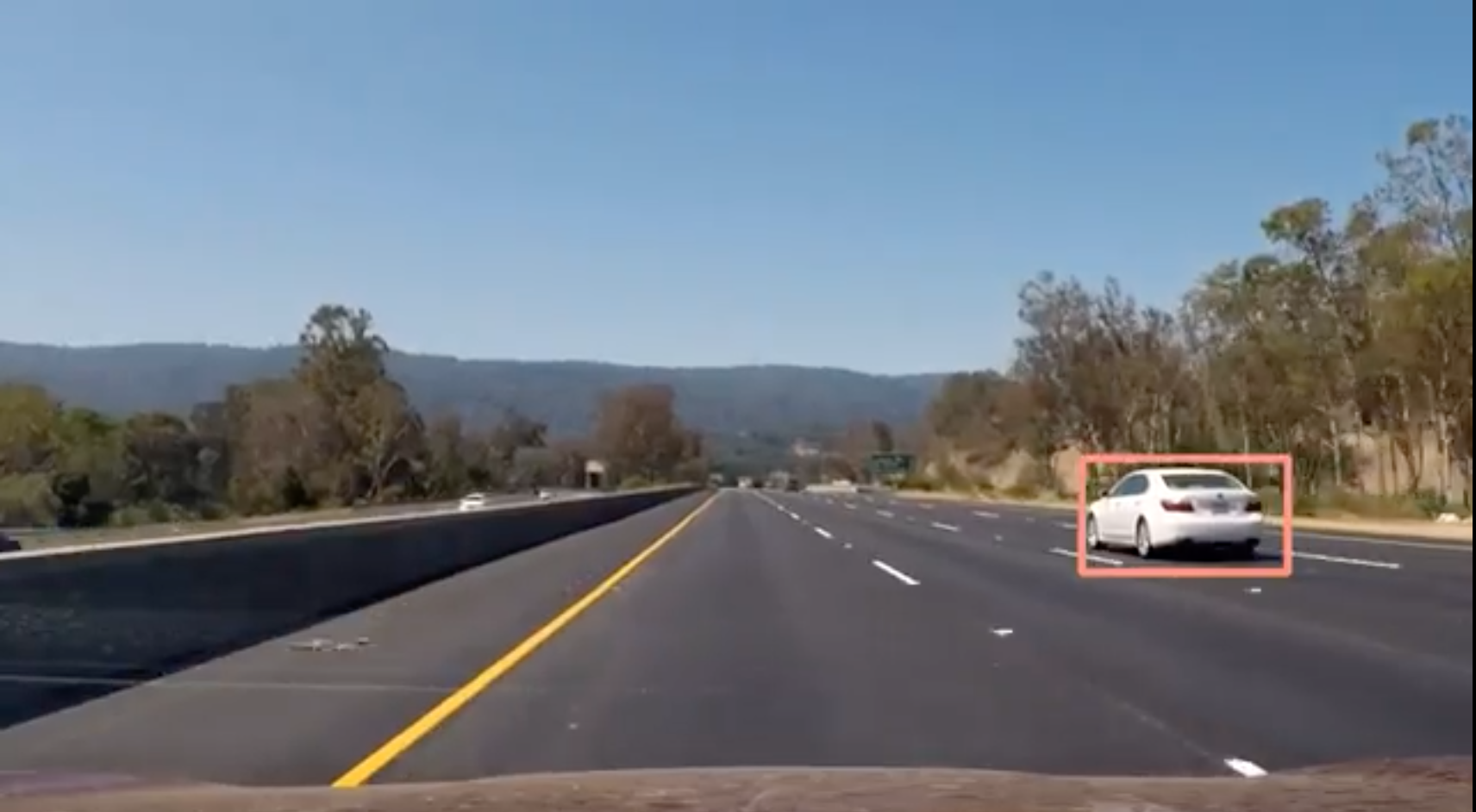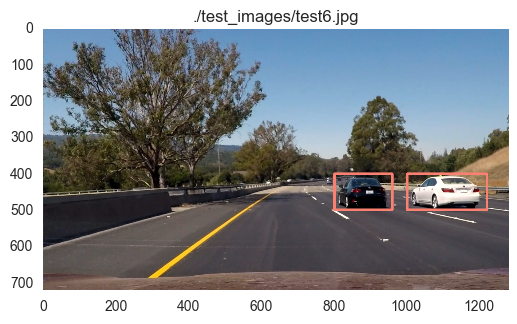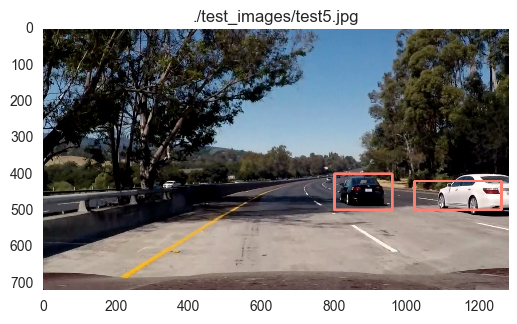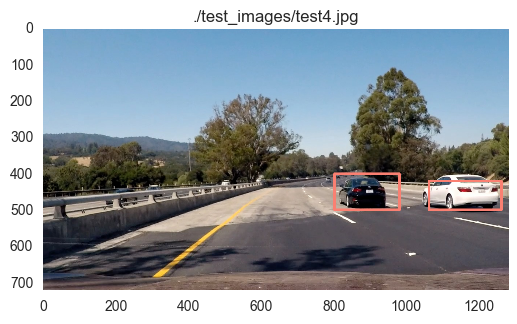The main goal in this project is to create a software pipeline to detect vehicles automatically in a video
The following video shows the final results of vehicles being detected:
Youtube link: https://www.youtube.com/watch?v=VKberP6XJqA&feature=youtu.be
The goals / steps of this project are the following:
- Perform a Histogram of Oriented Gradients (HOG) feature extraction on a labeled training set of images and train a classifier Linear SVM classifier
- Optionally, apply a color transform and append binned color features, as well as histograms of color, to a HOG feature vector.
- Note: normalize the features and randomize a selection for training and testing.
- Implement a sliding-window technique and use a trained classifier to search for vehicles in images.
- Run the pipeline on a video stream and create a heat map of recurring detections frame by frame to reject outliers and follow detected vehicles.
- Estimate a bounding box for vehicles detected.
Here are links to the labeled data for vehicle and non-vehicle examples to train a classifier. These example images come from a combination of the GTI vehicle image database, the KITTI vision benchmark suite, and examples extracted from the project video itself.
You are welcome and encouraged to take advantage of the recently released Udacity labeled dataset to augment your training data.
The project is implemented in two main files:
- Train Classifier - Feature extraction, PCA for dimension reduction, Grid Search for best model, training classifier and saving the models.
- Vehicle Detector - Use the above trained classifier to detect vehicles
- Notebook with base workflow - Shows exploratory data analysis, output of HOG, feature extraction, PCA results, training the classifier and results of tests on static images, including sliding window search and bounding boxes
The code for HOG feature extraction is in get_hog_features() in vehicle_detector.py(lines 41-59).
I first start by reading in all vehicle and non-vehicle images. Here are some images from the dataset:
I then explored various color spaces using skimage.hog() and parameter combinations of orientations, pixels_per_cell, and cell_per_block. Here is a sample of car and not-car HOG extraction:
Then using the YCrCb color space, I extracted the color histogram of images, as shown:
Using various combinations of features, by trail and error, I settled on the following config parameters for feature extraction:
### CONFIGURATION: Tweak these parameters and see how the results change. color_space = 'YCrCb' # Can be RGB, HSV, LUV, HLS, YUV, YCrCb orient = 9 # HOG orientations pix_per_cell = 8 # HOG pixels per cell cell_per_block = 2 # HOG cells per block hog_channel = 'ALL' # Can be 0, 1, 2, or "ALL" spatial_size = (32, 32) # Spatial binning dimensions hist_bins = 32 # Number of histogram bins spatial_feat = True # Spatial features on or off hist_feat = True # Histogram features on or off hog_feat = True # HOG features on or off y_start_stop = [400, 680] # Min and max in y to search in slide_window()
Features are extracted using extract_features() function in vehicle_detector.py (see lines: 80-130).
The total features extracted were about 8460. Since this is a large number for each image, I experimented with using Principal Component Analysis (PCA) for dimensionality reduction.
I used GridSearchCV from scikit-learn library to estimate a well working classifier. The classifers tested were SVC with PCA, and a LinearSVC. The code for this is implemented in perform_grid_search() in train_classifier.py (see lines: 138-172). PCA code is implemented in perform_pca() (lines: 103-136).
The results of PCA analysis are shown in the notebook.
The results of GridSearch and PCA showed that the best classifier was an SVC SVC(C=10.0, kernel='rbf', gamma=0.01) with n_components=64, thus reducing our dimension of features from 8460 to 64, a drastic reduction. This resulted in a classifier with 99.38% accuracy on the test set.
The model is saved in MODEL_FILE and config params in CONFIG_FILE defined in train_classifier.py for later use by vehicle_detector.py.
I used the sliding window search algorithm described in the lessons to create a list of windows to search for, and within the windows used the classifier to detect vehicles. The code is implemented in vehicle_detector.py in slide_window()(lines 132:177) and search_windows()(lines 229-290). The system is set to use varying window sizes (80x80 and 96x96) depending on whether we are searching near the horizon or closer. Using smaller window sizes (64x64) results in very large search times especially. The values currently used (80x80 and 96x96) were determined to reduce detection time, while still finding the vehicles optimally. Further tuning might be needed in some cases.
The sliding window output is shown here:
Once a vehicle is detected, we create a heatmap to show where the cars might be. See:
Finally, using a threshold on the heatmaps to remove false positives, we draw bounding box across the car. I experimented with various threshold levels (from 1 to 10), and found that smaller number (1-5) seemed to work best. However, there might still be some (very few) false positives.
To detect vehicles in a video, use the vehicle_detector.py with correct values for MODEL_FILE and CONFIG_FILE. (See lines: 531 onwards). The function process_frame() (lines: 424-516) implements the larger algorithm - define windows to search for, detect vehicles, draw boxes, and return each frame of the video.
The resulting video is here: !Track 1
This project was a complicated one chiefly due to two reasons: extracting correct features, and detecting vehicles. Both of these larger steps had several smaller steps that had to be optimized - defining the config params to extract features, finding the best classifier, and repeat. Then detecting vehicles also required going back to extracting more/different features and then testing out again on both static images and video. Perhaps most of the time was spent on defining correct window sizes, heat map threshold combination to detect images, but not find false positives.
There might still be some (small) false positives in the video.
Perhaps a better alternative would be to use Deep Learning techniques like Single-Shot Detector or YOLO for object detection. This could be experimented.














